State of the Union: Seagate's HAMR Hard Drives, Dual-Actuator Mach2, and 24 TB HDDs on Track
by Anton Shilov on February 7, 2019 2:00 PM EST- Posted in
- HDDs
- Storage
- Seagate
- Helium HDD
- HAMR
- Dual Actuator HDD
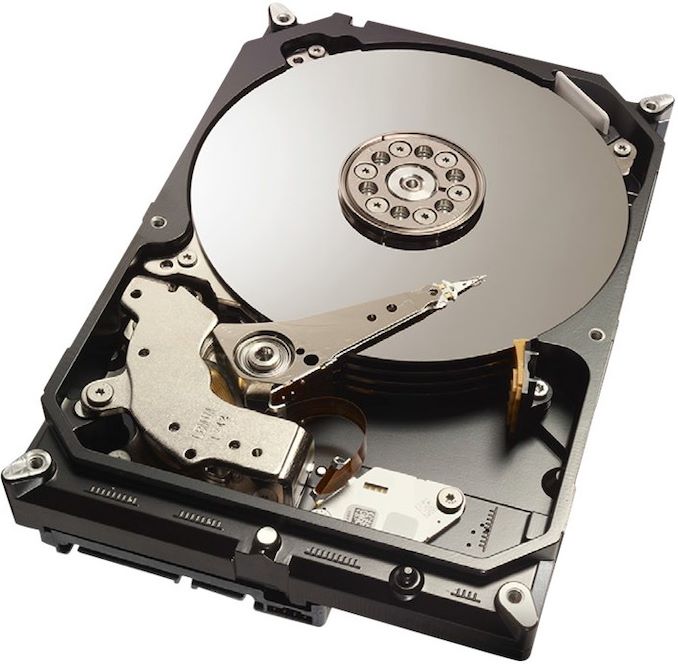
Seagate this week reiterated that the company is on track to launch two crucially important technologies later this calendar year. Firstly, the company plans to start ramping up its 16 TB hard drives featuring heat-assisted magnetic recording (HAMR) technology in 1H 2019. Secondly, the manufacturer intends to launch its first 14 TB HDDs featuring two actuators, up to 500 MB/s sequential read speed, and up to 160 IOPS later this year. Also, the company has stated that it is already testing its next iteration of HAMR that will enable hard drives with capacities up to 24 TB.
Table of Contents
- Need for Storage
- HAMR: Nearly Here
- 24 TB HDDs En Route
- Dual Actuator HDDs Ready for Prime Time
- First Multi-Actuator HDD: 14 TB, ~480 MB/s
- Final Thoughts
| Seagate's Datacenter and Exascale HDD Plans | |||||
| AnandTech.com | H1 2019 | H2 2019* | 2020 | ||
| Capacity | 16 TB | 14 TB | ~20+ TB | 16 ~ 20 TB | |
| Recording Technology | HAMR | PMR | HAMR | ||
| Performance | Over 250 MB/s ~80 IOPS 5 IOPS/TB |
~480 MB/s ~160 IOPS ~11 IOPS/TB |
? ~80 IOPS 4 IOPS/TB |
? | |
| Actuators | Single Actuator | Dual Actuator | Single Actuator | Dual Actuator* | |
| Notes: | *Not confirmed formally | ||||
Need for Storage
The market of hard drives is shrinking in terms of unit sales, but continues to thrive in terms of total capacity shipped as well as revenue. There may be some exceptions (e.g., Q4 CY2018), but the general trend is here. Unit shipments drop because modern laptops cannot accommodate a large 2.5-inch mechanical hard drive, whereas desktops can suffice with just one high-capacity Barracuda Pro-like storage device. What actually drives revenues in modern times are enterprise and exascale cloud datacenter-oriented HDDs that are used to enable services like Azure, Facebook, Gmail, iCloud, Netflix, Prime, and this is just to name a few.
Needless to say, that hard drives aimed at Apple, Facebook, Google, Netflix, Microsoft, and others are the first models to accommodate the latest technologies developed by Seagate (and other manufacturers), which is why it makes sense to pay a close attention to the company’s plans for datacenter HDDs in a bid to understand where the technology is going in general. Some of technologies found in such drives will eventually migrate to consumer HDDs.
HAMR: Nearly Here
HAMR (Heat Assisted Magnetic Recording) is something that Seagate has been working on for over a decade and this year it will finally hit mass production. Among other things, the HAMR technology posed two major challenges that Seagate had to solve. The first one is media itself that can handle a 450°C local heat (made using a laser with an 810 nm wavelength and a 20 mW power) without degrading over time. The second one is a writer with a near-field optical transducer (NFT) that heats the media and which also has to work without flaws for up to a decade or longer. Seagate has developed appropriate media and its writers can handle up to 4 PB per head data transfers, which is more than sufficient for modern enterprise/datacenter HDDs (that are rated for a 550 TB workload a year). In fact, the company says that not only its internally developed media and heads for HAMR HDDs meet datacenter requirements, but so do components designed externally as well.
Seagate officially started to ship its fully functional single-actuator Exos 16 TB HAMR-enabled helium-filled HDDs to select global hyperscale and OEM partners in early December for demonstration purposes. These drives are drop in compatible with existing server infrastructure and power consumption per unit does not exceed 12 Watts. In fact, it is in line with power consumption with other helium-filled HDDs since NFTs do not consume a lot of power at all.
Earlier this week Dave Mosley, CEO of Seagate, said that the company’s HAMR drives will be launched commercially in the first half of this year and will ramp after its partners validate them.
24 TB HDDs En Route
While Seagate is gearing up to launch its Exos 16 TB HDDs officially in the coming weeks or months, the company promises that its HAMR technology will enable it to release hard drives featuring ~18 TB ~ 20 TB or even higher capacities sometime next year. Furthermore, Seagate has already tested tech that will be used for 24 TB HDDs.
Late last year the company said that it had successfully demonstrated platters featuring a 2.381 Tb/in2 (Terabits per square inch) areal density in spinstand testing, which basically means a drive without an enclosure on a test bed. This areal density enables Seagate to make 3.5-inch platters with a 3 TB capacity. Eight of such disks can be used to build a 24 TB HDD. When it comes to longer-term future, Seagate once said that it had developed media with up to 10 Tb/in2 areal density in the lab.
Dual Actuator HDDs Ready for Prime Time
Another of Seagate’s technology that made headlines last year was the company’s Multi-Actuator Technology (MAT) designed to improve sequential and random read and random write performance of hard drives. On a high level, MAT improves MB/s and IOPS performance of HDDs, but a deeper look quickly reveals that this tech is crucial for the upcoming generations of datacenter hard drives in general and not only because of pure performance numbers.
It is well known that operators of exascale datacenters keep power consumption of servers and individual components in check because they can supply a relatively finite amount of power and remove a limited amount of thermal energy. It is also known that the majority of cloud datacenters use SSDs for frequently accessed data and nearline (near online) HDDs to store data that is accessed a bit less regularly. SSDs enable operators of the said datacenters to provide certain services instantly, but even when they need to access data from hard drives, there is a strict standard when it comes to time they need to access their data within their datacenter.
In general, today’s 3.5-inch HDDs offer random performance of 6 – 10 IOPS per terabyte, which is sufficient for contemporary datacenters and is enough to ensure their quality-of-service requirements. Meanwhile, as hard drives gain capacity, their random performance per terabyte drops and once it drops below 5 IOPS per TB (which is believed to be the lowest target for many modern datacenters), such HDDs will no longer meet service level agreement and therefore QoS requirements. Consequently, operators who do not meet their IOPS per TB requirements (whether these are 4, 5, or 7 IOPS per TB) need to either reduce the amount of capacity they use per drive (i.e., buy smaller drives, or pay for capacity they cannot use), or demand drives that offer a higher I/O performance. This was explained Jason Feist, Seagate’s Director of Technology Strategy and Product Planning who is responsible for the company’s datacenter product roadmap.
At present, Seagate can tune hard drives to deliver I/O that its customers require by implementing command queuing and latency-bounded I/O (LBIO) in firmware (i.e., lower performance), but at some point, these methods will cease to work efficiently. In particular Seagate says that at ~16 TB and beyond more and more customers (but not all of them) will need HDDs that could physically feature a higher I/O performance.
To improve I/O performance of next-generation hard drives, both Seagate and Western Digital plan to install two (or more) sets of actuators into a single HDD. The actuators are to be outfitted with their own arms/heads as well as magnets to position them, but will use one pivot. Therefore, the actuators will work autonomously, basically producing parallelism within a single HDD. As hard drives gain ability to read or write with more than one head at any given time, their random read/write performance will scale with the number of actuators. Sequential read/write performance of HDDs will also increase all the way to 480 MB/s (in case of the first-gen MAT-enabled HDDs), but as it will depend on numerous factors, it is hard to make predictions about throughput of next-gen hard drives.
The extra components needed for two independent actuator assemblies (and a considerably more sophisticated HDD controller) will make such HDDs a bit costlier to manufacture when compared to today’s models. This is a reason why going forward Seagate will have at least two lineups of HDDs for hyperscale workloads: one guaranteeing optimal IOPS per TB with multiple actuators and another guaranteeing minimum IOPS per TB and aimed at customers who can manage required performance levels.
First Multi-Actuator HDD: 14 TB, ~480 MB/s
Seagate’s first-generation MAT-enabled HDDs, dubbed Mach2, use two actuators operating on a single pivot point (along with 8 platters and 16 heads). These drives are set to feature a 14 TB capacity, 480 ~ 500 MB/s sequential read/write performance, as well as up to 160 IOPS. What is not completely clear is how much power will these HDDs consume, as the only thing that Seagate says is that they will consume significantly less than two HDDs. The key thing here is that the drives will still be drop-in compatible with 3.5-inch bays, which is the most important thing for operators of exascale datacenters.
Seagate says that it had supplied prototypes of its Mach2 HDDs to its partners and such drives had been used for “live production traffic” for months now. Their volume ramp will begin later this calendar year, yet Seagate does not elaborate.
Final Thoughts
With plans to launch two crucially important technologies in 2019, this year will be fundamentally important for Seagate. The company is ahead of its rivals with its HAMR and multi-actuator technologies, but now it needs to execute and deliver appropriate HDDs to interested parties. Next year will also be important for Seagate as it will have to bring together its HAMR and multi-actuator technologies and offer rather unique drives to its customers.
As noted above, many technologies originally developed for enterprise and exascale datacenter hard drives usually migrate to HDDs aimed at high-end desktops, workstations, and NAS. Obviously, both HAMR and MAT make a great sense for all of the aforementioned applications, but it remains to be seen which of the technologies will be used for “civil” PCs and storage devices first.
Related Reading
- Seagate Starts to Test 16 TB HAMR Hard Drives
- Seagate’s Multi Actuator Technology to Address HDD IOPS Woes
- The Evolution of HDDs in the Near Future: Speaking with Seagate CTO, Mark Re
- 16 TB MAMR Hard Drives in 2019: Western Digital
Source: Seagate


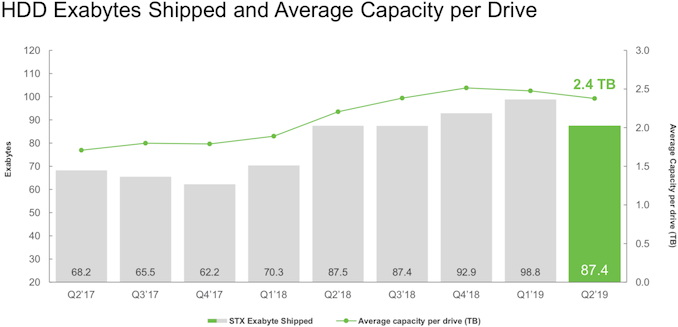

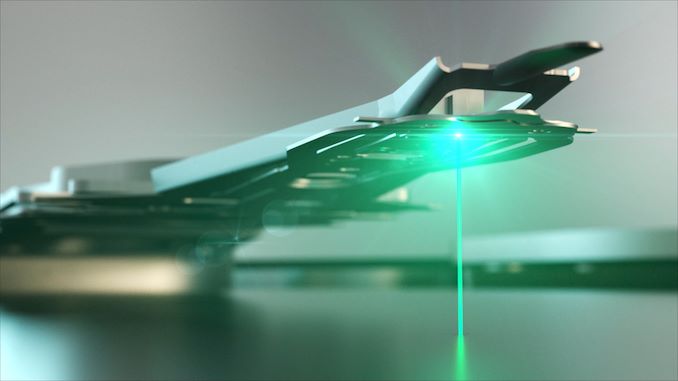

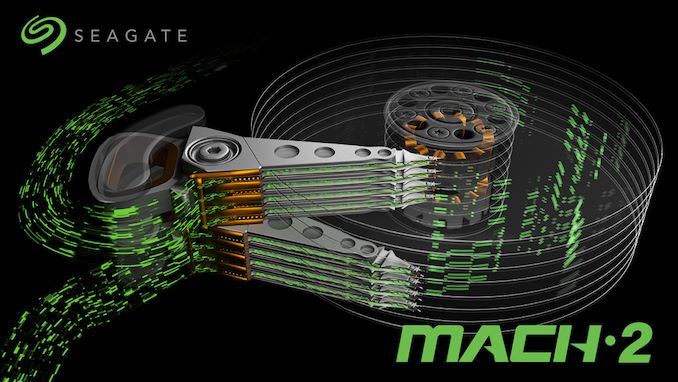
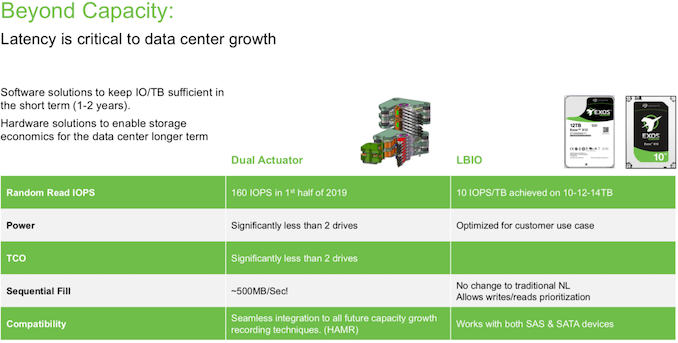









54 Comments
View All Comments
MFinn3333 - Thursday, February 7, 2019 - link
I don’t think it is going to make it into consumer PC. Besides to fill up something like 24TB HDD at 250MB/s would take 96,000 seconds in the best case scenarios.SSD’s are just getting way too inexpensive for just good enough storage. Especially in the 1-2TB SSD.
Korguz - Thursday, February 7, 2019 - link
maybe.. but until SSDs capacity is a lot higher.. mechanical hdds will still have their use in consumer comps... 2 tb.. is not enough room for some things like music or movies....bill.rookard - Thursday, February 7, 2019 - link
Exactly, I have a server in my basement with about 20TB of space (4x4tb + 4x3tb in a ZFS array) and it's about half full. I could put together a similar system with SSDs if they offered affordable 4tb sizing, but they just don't.3/4TB drives are dirt cheap right now, and with a good ZFS array offer enough performance to more than saturate a 1Gbit link.
PeachNCream - Thursday, February 7, 2019 - link
I think it's safe to say most people don't have a server in their home and that your storage needs represent an edge case rather than the mainstream norm. Average folks tend to stream their video content and maybe grab a few shows on a cable company-supplied DVR box. Smartphone ownership in the US has outpaced desktops and laptops combined and the number of households where people do not own PCs at all, but instead rely exclusively on phones is increasing. PCs aren't dead, but desktop hardware in the home is on a steady decline with businesses and PC gamers propping up an increasingly premium-priced market segment that is shrinking due to self-inflicted rising cost wounds. I expect laptops will follow suit eventually as well though they are currently consuming the desktop market. Servers sitting at homes...well this is a tech site and even here you represent a sub-majority of the reader population.Korguz - Friday, February 8, 2019 - link
i have a NAS box too :-) heheheh even if i didnt.. the sizes of SSDs.. are just not big enough for my usage needs still...BTW.. 1 tb ssds are not too bad price wise.. but 2tb... minimum 350, for the 2.5 inch version, m.2 is 530... dont know about you but thats not inexpensive in my books :-)
Schmich - Friday, February 8, 2019 - link
Most people don't buy high-end hard-drives either.SSD took up the low-end market and boot drives for enthusiasts. But HDDs will always be there for the rest. People have been saying for 10 years now that HDDs are about to die. They won't. We need so much storage. The average enthusiast definitely has a NAS of some sort. And us who takes a lot of RAW images or video have an extensive NAS. For either of those, SSDs are too expensive or too small in capacity. At best you can use one as cache/buffer.
FunBunny2 - Friday, February 8, 2019 - link
"The average enthusiast definitely has a NAS of some sort."but... that's not the average buyer. your 'average' doesn't comport with the 'average' user who needed support for Win95/Office/etc. the numbers aren't even close.
PeachNCream - Sunday, February 10, 2019 - link
Yup, we're talking about someone that represents society's middle ground which varies from an individual using a phone as their primary computer to a family with a desktop computer and a couple of laptops for the kids. Those sorts of people are unlikely to be familiar with the idea of networked storage beyond leaving files in "the cloud" with Google or via OneDrive, the underlying technologies of both they don't understand and have no need to learn. Those sorts of people and the variations of those people out there represent the bulk of the world and are the average folks to which I'm referring.wumpus - Friday, February 8, 2019 - link
Don't expect Dell/HP to ship HDDs to the "average person" much longer, as a 1TB drive is pretty much the minimum (although I assume OEMs manage to buy cut down 500GB for reasons). Another thing is that most people seem to use about 100GB of space, so a 256GB drive is probably enough for a consumer drive, and the same price as a 1TB drive (and probably going below it soon enough).For those "normal people" who need more capacity (I'm specifically thinking about my father, who while he's used computers for nearly 40 years still doesn't get the idea of saving things to anywhere but the desktop) I'd strongly recommend AMD's StoreMI caching system (or other ones, but anything else is probably outside the realm of average people). 3-4TB rotating data (dirt cheap storage per bit) and a 256GB SSD cache ($40 tops?) should work wonders.
Korguz - Friday, February 8, 2019 - link
most people dont.. i agree.. but those that do.. ssds just dont have the capacity, and get mechanical ones for storage, and ssds for other things... OS boot drive, drive to install games on.. etc....